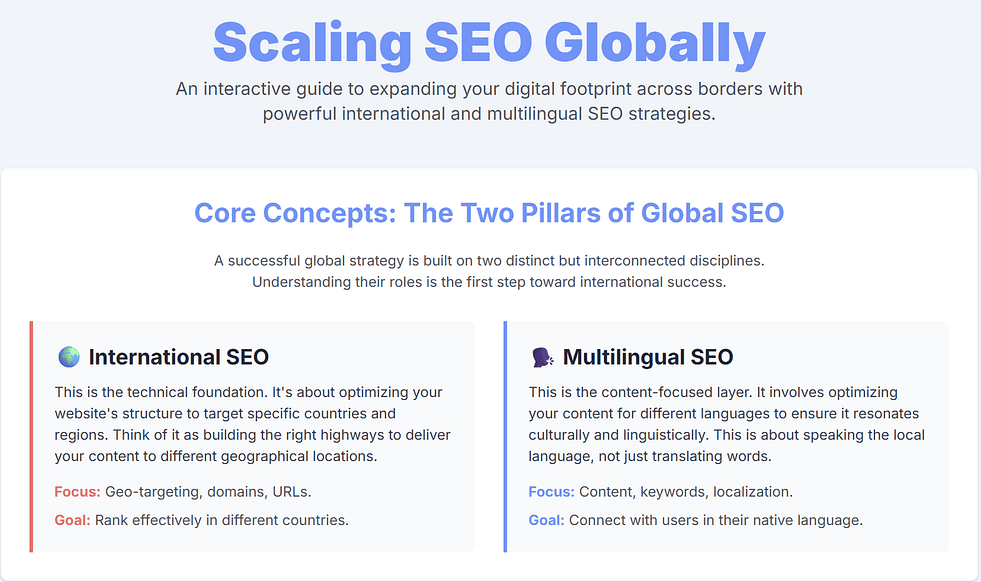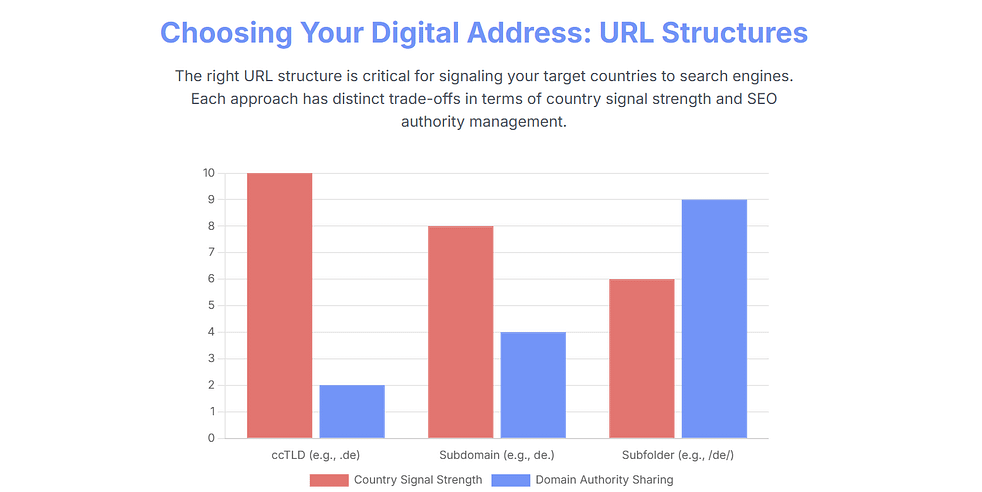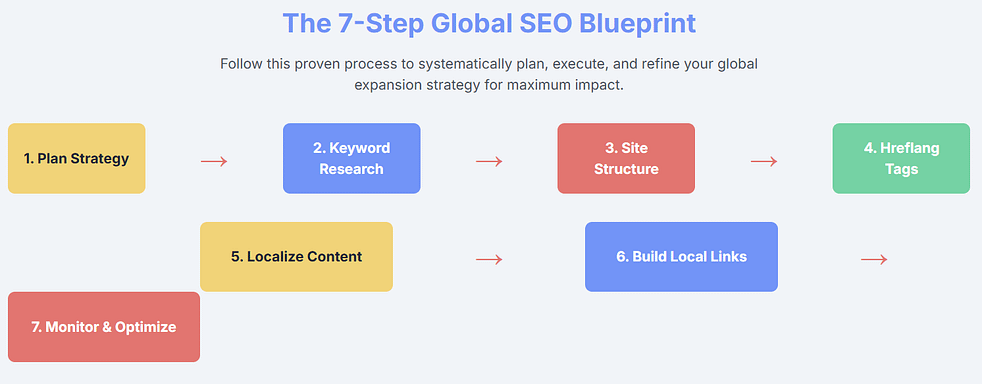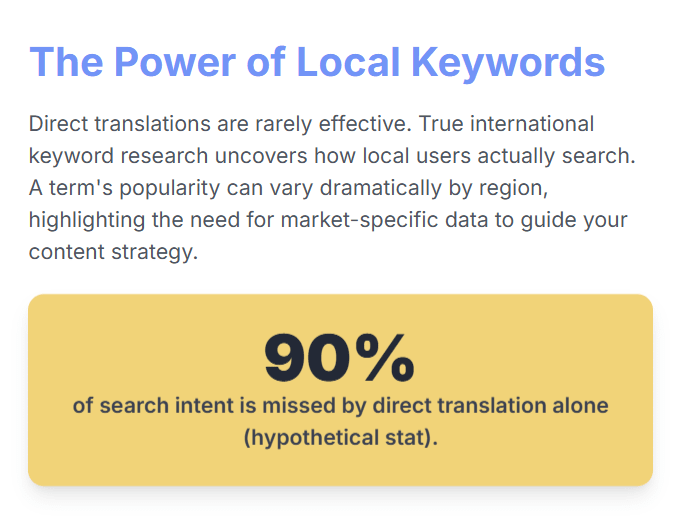Expanding an online presence across borders requires more than just translating content. International SEO is the strategy of optimizing your website to serve different countries and languages, ensuring the right content reaches each audience in their preferred language and region. Multilingual SEO (optimizing content in multiple languages) is a key part of this process. A crucial first step is thorough international keyword research to understand local search demand. In this post, we’ll share actionable international SEO and multilingual SEO techniques and best practices for scaling your site globally.
International vs Multilingual SEO
International SEO covers optimizing your site for multiple countries and regions (using geo-targeting, country-specific domains or URLs). Multilingual SEO focuses on optimizing content in different languages within that framework. They go hand in hand: effective global strategy combines robust international SEO (domains, hreflang) with thorough multilingual SEO (localized content). Both international SEO and multilingual SEO together ensure your site performs well in every market.

Planning Your Global SEO Strategy
A solid international SEO plan starts with research: pick target countries and languages by market size and demand. Use Google Analytics or Search Console to find where current traffic comes from by country. Analyze local competitors and consumer behavior to gauge opportunities. Compile a prioritized list of target markets. Then perform thorough international keyword research for each region. Also plan for multilingual SEO (localized content and keywords) from the outset.
International Keyword Research
As part of your international SEO strategy, for each target market perform international keyword research. Direct translations rarely match local search intent. Start with seed terms and translate them (using DeepL or Google Translate) to generate initial ideas. Then use keyword tools set to the local region:
- Google Keyword Planner (set location/language)
- Ahrefs Keywords Explorer (choose country in filters)
- SEMrush Keyword Magic Tool (target by country)
- Google Trends (compare term popularity by country)
Collect search volumes and competition metrics for each term. You may find local synonyms or idiomatic terms that perform better than literal translations. Organize your keyword lists by country and language. Effective international keyword research yields tailored keyword lists for your content strategy. Update your international keyword research regularly as search trends change.

Structuring Your Site for Multiple Languages
Choosing the right URL structure is vital for international SEO. Options include:
- Country-code top-level domains (ccTLDs) (e.g., example.fr, example.de): strong country signals, but require separate SEO.
- Subdomains (e.g., de.example.com): geotargetable, but often behave like separate sites.
- Subfolders (e.g., example.com/de/): share domain authority and are easiest to scale (still require Hreflang annotations).
Pick one model and use it consistently. Many sites prefer subfolders for shared authority. Whatever structure you choose, implement Hreflang tags and correct HTML lang attributes on each page. Set country targeting in Search Console for your subdomains or folders if needed.
Hreflang Tags and Language Targeting
To avoid duplicate content, add <link rel=”alternate” hreflang=”x”> tags to each language page. These tags tell search engines which language or regional version to serve users. For example, an English page might reference a French page and vice versa:
<link rel=”alternate” hreflang=”en” href=”https://example.com/en/page” />
<link rel=”alternate” hreflang=”fr” href=”https://example.com/fr/page” />
Include a self-referencing tag as well. Some tools or plugins automate Hreflang, but always verify the tags. Proper Hreflang ensures users see the correct language version and prevents duplicate content.

Content Localization
True multilingual SEO means more than translation; it’s a core part of international SEO strategy. Localize your content for cultural relevance. Adapt date formats, currencies, examples, and slang for each market. Translation tools like DeepL can create initial drafts, but always have a native speaker review and refine.
Optimize on-page elements (titles, meta descriptions, headings, alt text) in each language using your international keyword research.
For WordPress sites, plugins like Weglot or WPML manage multilingual content by creating separate URLs. They often handle Hreflang automatically, but manually verify their translations and tags. Always serve one language per URL to avoid confusion and indexing issues. Strong multilingual SEO means consistently optimizing each language version.
Technical Considerations
Global SEO requires strong technical foundations:
- Site speed: Use a CDN or local hosting to load pages quickly worldwide (page speed is a ranking factor in international SEO). Optimize images and minify code for all language versions.
- Mobile usability: Ensure your responsive design handles longer translated text without breaking. Test on common devices in each region. Good mobile UX is important for international SEO.
- Local UX: Display prices, addresses, and contact info relevant to each country.
Audit each language section with tools like Google Search Console or Screaming Frog. Fix crawl errors, broken hreflang tags, and duplicate meta tags. A clean technical setup is critical for global SEO success.

Local Link Building
Backlinks remain an important ranking factor globally. To build authority in each market:
- Reach out to local publications or industry blogs for guest posts and mentions in the target language.
- List your site in country-specific directories or Google My Business.
- Engage on local social media to build brand presence and earn links.
- Use Ahrefs or SEMrush to analyze competitor backlinks and try to earn similar links.
Local backlinks signal relevance to search engines and support your international SEO efforts by improving visibility in each region. Also, ensure your link building aligns with your multilingual SEO goals by linking content in each target language.
Monitoring and Optimization
Track international SEO performance for each market. In Google Search Console, use country filters or separate properties to view search analytics by region. Set up separate Google Analytics views or filters by location. Use rank tracking tools (Ahrefs, SEMrush) to monitor keyword positions in each country’s SERPs.
Compare metrics like organic traffic, bounce rate, and conversions across markets. If a market underperforms, revisit your international keyword research and content. SEO is iterative: update content and keywords based on what the data shows. Incorporate new international keyword research insights as they arise. Also refine your multilingual SEO as you adapt content.

Conclusion
Scaling SEO globally is challenging but rewarding. Choose a solid site structure (ccTLD, subdomain, or subfolder) and implement proper hreflang tags and lang attributes for each language. Perform thorough international keyword research for each target language and adapt your content accordingly. Leverage tools like Google Search Console, Ahrefs, SEMrush, DeepL, and Weglot to manage tasks. By applying these international SEO and multilingual SEO techniques, you can expand your site’s presence in global markets. Use international SEO and multilingual SEO in tandem to reach audiences worldwide. Continuous international keyword research and updates ensure your strategy keeps pace with market changes. Best practices in multilingual SEO should be applied continuously.
FAQ
Q: What is the difference between international SEO and multilingual SEO?
A: International SEO optimizes your site to rank across different countries (using geotargeting, domains, subfolders, etc.). Multilingual SEO optimizes content for different languages. Both are part of a global search strategy.
Q: How should I structure my site for multiple languages or countries?
A: Use country-specific domains (example.fr), subdomains (fr.example.com), or subfolders (example.com/fr/) for each region. Subfolders often retain more SEO value, while ccTLDs clearly signal a country. Choose one structure and use it consistently. Use Hreflang tags on every page and set country targeting in Google Search Console.
Q: What tools can help with international keyword research?
A: For international keyword research, use Google Keyword Planner, Ahrefs Keywords Explorer, or SEMrush (with location/language filters) to find local keywords. Google Trends compares term popularity by country. Translation tools like DeepL can provide keyword ideas, but always verify them with real search data in the target language.
Q: How can I avoid duplicate content issues when targeting multiple languages?
A: Use separate URLs and proper Hreflang tags for each language version. Include the lang attribute on each page. Ensure each translation is unique. Proper Hreflang tells search engines which version to serve, preventing duplicate content.




